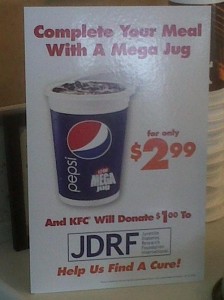Catching up with items about beverage marketing
I’ve been saving up items about beverages, mostly having to do with marketing:
Soda companies vs. civic public health campaigns: In strategies reminiscent of those used by tobacco companies, soda companies are filing suit to obtain documents from public agencies all over the country. Digging them up takes staff time and effort and slows down the real work of these agencies—the point of this approach.
Sonic’s marketing campaign, Limeades for Learning (“when you sip, kids learn”) encourages purchasers of its high-calorie drinks (620 for a medium, 950 for a large) to vote for school projects.
Dr Pepper Snapple’s diet—oops, low-calorie—10-calorie Dr Pepper Ten is aimed at men. Men, it seems, like low-calorie sodas but squirm at the notion of diet sodas.
Coke covers both bases. Diet Coke targets women and Coke Zero targets men in an “it’s not for women” campaign. Is this ad offensive? It not only excludes half the market, says Food Navigator’s Carolyn Scott-Thomas, but is
patronizing to both men and women in its reinforcement of what I had (perhaps naively) hoped were outdated stereotypes….It deliberately picks at the edges of our comfort zones. Is it OK to be sexist if it’s done with irony?…Provocation is a blunt instrument. It may prove effective for sales—perhaps as effective as sexually explicit marketing—but it is still crude and obtuse.”
She asks: “Would this ad be offensive if it involved a bunch of redneck clichés and proclaimed ‘it’s not for blacks’? You bet it would.”
Coca-Cola has launched a global music effort to connect with teens. Coke CEO Muhtar Kent says:
Our success in growing our sparkling category today depends on our ability to grow and connect with teens, the generation of tomorrow.
Pepsi, not to be outdone, has invented a social marketing vending machine for the digital age. Buy a drink and you now have the opportunity to send one as a gift to a friend or a random stranger.
The Committee on Nutrition, American Academy of Pediatrics weighs in on sports and energy drinks. Its tough report begins with the statement that “Sports and energy drinks are being marketed to children and adolescents for a variety of inappropriate uses.”
Sports drinks…may contain carbohydrates, minerals, electrolytes, and flavoring and are intended to replenish water and electrolytes lost through sweating during exercise.
In contrast…energy drinks also contain substances that act as nonnutritive stimulants, such as caffeine, guarana, taurine, ginseng, l-carnitine, creatine, and/or glucuronolactone, with purported ergogenic or performance-enhancing effects.
The report ends with this unambiguous conclusion:
the use of sports drinks in place of water on the sports field or in the school lunchroom is generally unnecessary. Stimulant containing energy drinks have no place in the diets of children or adolescents.
In response, Red Bull says it is not marketing to children. Instead, it says, the company totally follows the “agreed codes of practice for the marketing and labelling of energy drinks.”
Just for fun I looked up some advertising budgets reported in Advertising Age. For 2010, Coca-Cola spent $267 million just to advertise Coke, Pepsi spent $154 million just to advertise Pepsi and another $113 million for Gatorade, and Dr. Pepper spent a mere $22 million for Snapple.
These expenses are just for those individual products and just for campaigns run through advertising agencies. Pepsi’s total advertising budget that year was $1.01 billion.
Water, anyone?



